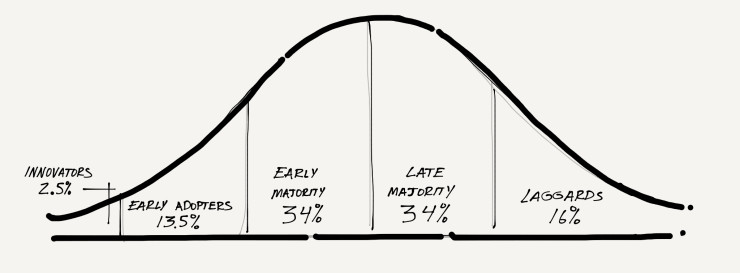Teacher: Know Thyself – School Culture Shift is About the People
Every good quest-adventure story has a team of contributors, each with a special skill set that contributes to the team’s successes.

“Courage is contagious. When a brave man takes a stand, the spines of others are often stiffened.” – Billy Graham
Think: Lord of the Rings, Harry Potter, or Star Wars, every good quest-adventure story has a team of contributors, each with a special skill set that contributes to the team’s successes. They fumble about lampooning the human experience on their way to epic saga-like success. We are often engaged by both their plight and how we can relate to them. A key character in these stories is the hero, or champion.
If you are reading this blog post it is likely that you are the champion, my friend, and that you will keep on fighting until the end, since there’s no time for losers, cause you are the champion of the world…. but I digress.
Champions
Many champions feel more like an imposter than an expert or leader. Perhaps it is this feeling that drives champions to keep learning and growing toward mastery. The mastery for the future is not in a tool or workflow solution, it is found in innovativeness, in the champion’s ability to change.
A champion is someone that is instrumental in successfully guiding projects through the approval hurdles: displaying persistence, expressing strong conviction in the innovation, and involving key individuals.1 In our quest for innovativeness we can embrace this role for ourselves and/or find allies within these ranks. The adoption of an innovation by an organization is more likely if key individuals (champions) are willing to support the innovation.2
This willingness is extremely important. We can very easily take the role of bystander in our school community. The bystander effect3 is a scary aspect of the human experience that we must all work against. It explains to us that we may look at a problem as “not ours” or that “someone else will take care of it.” This is a paralyzing condition that actively works against positive change in our schools. Champions are just the people who believe in positive change.
Champions are the organizational mavericks, they exist within a system but are given autonomy to explore alternative, creative solutions. They can be transformational leaders, who harnesses support from other members of the organization.2 The impact of a champion on both the adoption and sustainability of an innovation is undeniable. Selecting individuals who display these particular champion behaviors can increase the probability that adoption of innovation occurs.1 A champion in the organizational adoption process is someone who possess the certain attributes and skills. Champions are credible experts and planners that can network well with colleagues since they are perceived as sensitive to colleagues needs by demonstrating an objective approach to finding meaningful solutions. An innovation champion must be tenacious, assertive, decisive and should instill passion and positive thinking in the innovation process.4
Tools and ideas to transform education. Sign up below.
[Game-Based Learning Yields Empathetic Understanding]
Adopters
You can take a personality test, a learning style inventory, or even a which-character-are-you quiz, but I would argue the power of meaningful self-perception. Perhaps a better title for this chapter would be “Who do you think you are?” It is extremely important that we recognize our strengths and weaknesses in our professional practice, such recognition can lead to real, positive growth. While you may take up the role of champion as a general way of perceiving your fit within your school system, we may find ourselves identifying with one adopter category or another when discussing emergent technology. We call these categories: Innovators, Early Adopters, Early Majority, Late Majority, and Laggards.5 Adopter categories can be illustrated on a bell curve on the basis of innovativeness.

Innovators: “Lets do this!”

Innovators are interested in new ideas from outside of established local social system. Able to understand and apply complex technical knowledge. Innovators must be able to cope with a high degree of uncertainty about an innovation at the time of adoption. Innovators are risk takers, they learn from failure like a gamer.
Early Adopters: “Describe the value in it and how to do it and I am all in!”

Early Adopters are invested and respected in the local school community. They are cautious and want their efforts informed by research if not best practices. Early Adopters are not known for risk taking, but have a reputation for well-thought out execution of emergent technology. Change agents seek this group out a local voice missionary for speeding the adoption of innovation.
Early Majority: “Show me my colleagues using it and I will try it too.”

The Early Majority adopt just before the average person making them an important link in seeing the adoption process successfully take off. The Early Majority wants to employ best practices based on the experiences of Innovators and Early Adopters. They will make the necessary changes but do not want to go first.
Late Majority: “I am a team player, I will support this but I probably will not be the best at it.”

The Late Majority adopts just after the Early Majority. They adopt sometimes due to economic pressure, peer pressure, or both. The Late Majority must see the innovation as already being successful before they adopt. You might call the Late Majority our “team players” since they are willing to join the other adopters once they realize it is for the greater good. The Late Majority may not be super excited about technology of any particular kind but they make the change for the benefit of their school community.
Laggards: “I am not convinced this will benefit my classroom. I have done fine without it.”

Laggards are near isolates in the school community. Their point of reference is past practice and past perceived successes. Laggards must be positively certain that a new idea will not fail before they can adopt. They are concerned about being blamed if the innovation fails to yield expected results.
A review of these adoption categories is relevant for several reasons, it will help us predict how our colleagues may feel about adopting emergent technology, and this review will help us understand how to find Early Adopters who often have respected Champions in their ranks. Further, these adoption categories help us to better understand the sphere of influence each adopter has. For example, an Innovator can inspire Early Adopters and potentially some Early Majority, but would be hard pressed to motivate a Laggard. Why? Innovators can be seen as people doing some pretty far out there stuff, beyond the skill set of later adopters. Innovators, by definition are risk takers, they accept failure in a ways that make some people uncomfortable. This is why Early Adopters often serve as more effective Champions, they make up a larger percentage of people and have a reputation for a more measured approach to adoption.
Derek Siver’s Ted Talk “The First Follower: Leadership Lessons from a Dancing Guy”6 illustrates the importance of Early Adopters in the Adoption process (If you have not seen this three-minute video, please check it out). Siver’s explains that a Leader (Innovator) has the guts to stand out and be ridiculed, but that does not start a movement. The First Follower (Early Adopter) who joins the Leader validates the movement (Adoption) and makes it appear less risky for others to follow. These Late Adopters model their behaviors of after the First Follower, not the Leader. The movement gains momentum and then we see a real shift in cultural adoption. In this account, we must understand that the Leader treats the First Follower as an equal, as a co-leader.
Additional key roles include opinion leaders who have informal influence and change agents who positively influence innovation decisions. Change agents work to develop a need for change on the part of the client, establish an information-exchange relationship, diagnose the client problem, develop an action plan, implement, and shift the client from reliance on the change agent to self-reliance.5,7
Decision Making
If you are a decision maker for a school or organization there are multiple types you might consider which affect the adoption of innovation process. These types might even be considered steps toward adopting innovation: (1) Optional innovation-decisions, (2) Collective innovation-decisions, and (3) Authority innovation-decisions.
Optional innovation-decisions: The choice to adopt or reject an innovation is made by an individual independent of the decisions by other members of a system. The individual’s decision can be influenced by the norms of the system and by communication through interpersonal networks.5 An example of this may be a teacher from a school choosing to go paperless at their school while their colleagues continue to teach with paper.
Collective innovation-decisions: The choice to adopt or reject an innovation is made by consensus among the members of a system.5 An example of this may be like the above-mentioned person, except at a department level choosing to go paperless.
Authority innovation-decision: The choices to adopt or reject an innovation is made by a relatively few individuals in a system who possess power, high social status, or technical expertise.5 An example of this may be where upper-level leadership has decided their school community will go paperless so they will no longer purchase printers, ink or service photocopiers.
As a leader, if you were to allow your Innovators and Early Adopter, the flexibility to make optional innovation-decisions. Their successes may naturally lead the Early and Late Majority joining them in a collective innovation-decision. Finally, it may take the authoritative approach to move the Laggards forward in the desired adoption.
If perhaps you were to approach this same list of categories with topics like Virtual and Augmented Reality, the Maker Movement, Coding, and/or Robotics… you may find yourself in a different adopter category. The Maker Movement’s Innovator may also be the Robotic’s Laggard, and there’s nothing wrong with that. We all learn and grow at different speeds and in different ways. Identifying the value of emergent technology within the context of our classroom needs and content is the first step toward becoming a change-agent in our professional communities. The level of perceived relevance in our classroom will likely inform our adoption category and approach with any innovation. Once a specific innovation becomes a seamless part of our classroom we have reached the pinnacle of innovative adoption.
Image Credit: Chris Stein, a superstar Teacher, and illustrator Extraordinaire!
cross posted at micahshippee.com
Micah Shippee, PhD is an out-of-the-box-doer, a social studies teacher, and a technology trainer. He works to bridge the gap between research and practice in the educational sector. Micah explores ways to improve motivation in the classroom and seeks to leverage emergent technology to achieve educational goals. As an innovative "ideas" person, Micah likes to think, and act, outside the box. Micah is motivated and energetic, taking a creative approach towards achieving goals. As an Educational Consultant, and Keynote Speaker, he focuses on the adoption of emergent technology through the development of an innovative learning culture. Micah believe that innovativeness is the pedagogy of the future.
Source Notes
- Howell, J., Shea, C., & Higgins, C. (2005). Champions of product innovations: Defining, developing, and validating a measure of champion behavior. Journal of Business Venturing, 20(5), 641-661. Retrieved from: http://www.sciencedirect.com.libezproxy2.syr.edu/science/article/pii/S088390260400075 8#
- Greenhalgh, T., Robert, G., Macfarlane, F., Bate, P., & Kyriakidou, O. (2004). Diffusion Of Innovations In Service Organizations: Systematic Review And Recommendations. The Milbank Quarterly, 82(4), 581-629. Retrieved from: http://onlinelibrary.wiley.com/doi/10.1111/j.0887-378X.2004.00325.x/full
- Darley, J. M. & Latané, B. (1968). “Bystander intervention in emergencies: Diffusion of responsibility”. Journal of Personality and Social Psychology. 8: 377–383. doi:10.1037/h0025589. https://pdfs.semanticscholar.org/9c2f/63826605843d83fd08f56fbf75790cf74614.pdf. Accessed 17 Apr. 2018.
- Daily, Alisia (2014). “Social Innovation and Innovation Champions: An Analysis of Public and Private Processes.” Diss. Virginia Commonwealth U, 2014. Abstract. VCU Scholars Compass, n.d. Web. <https://scholarscompass.vcu.edu/cgi/viewcontent.cgi?referer=&httpsredir=1&article=4460&context=etd>.
- Rogers, E.M. (2003). Diffusion of innovations (5th ed.). New York: Free Press.
- Sivers, D. “Leadership Lessons from Dancing Guy | Derek Sivers.” https://sivers.org/dancingguy. Accessed 17 Apr. 2018.
- Clarke, R. (1999, Sept). Roger Clarke’s innovation diffusion theory. Retrieved from http://www.rogerclarke.com/SOS/InnDiff.html
